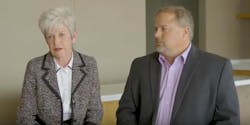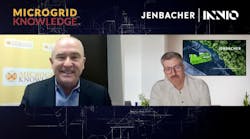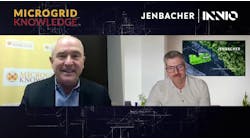Karen Morgan, CEO of Dynamic Energy Networks, and Mark Feasel, vice president, utility and smart grids at Schneider Electric, describe financing innovations, energy-as-a-service and other advantages their partnership brings to the microgrid market. Elisa Wood, editor-in-chief of Microgrid Knowledge, interviews the two industry leaders.
Dynamic Energy Networks and Schneider Electric are teaming up to help simplify some of the questions around energy and microgrids for their clients, and remove common challenges that often block microgrid development for businesses and institutions.
Feasel explained that the two companies have been busy over the past six months as the microgrid market continues to accelerate. But companies like Schneider Electric and DEN are fielding a growing number of questions from clients and potential customers about the true meaning and value of microgrids.
“This idea of microgrid resilience, sustainability and cost is already a building topic, and now as people think about how they can embrace those ideas in new ways, the questions continue to get more sophisticated, and they really come at it from all angles,” Feasel said.
This reality, Feasel said, highlights the importance of establishing partnerships and answering some of these questions together as an industry.
Microgrid 2019 will be held in San Diego next May 13-16
Morgan describes the Schneider partnership and her company as being in the “excuse removal business.”
When asked to explain, Morgan pointed out DEN has strategic capital, backed by private equity infrastructure investor the Carlyle Group, which is involved in a variety of different energy and transportation markets.
“So we bring that background of innovative structuring and financing. And that combination, with Schneider and its technology, essentially removes the excuses. Customers are able to make a decision quite easily because we deliver a holistic solution,” said Morgan.
In other words, they make it easier for their customers to explore and implement microgrids.
Just years ago, power decisions were a lot simpler. Now, energy users have to ask utilities questions such as: Where are you going to site your generator? What kind of generator are you going to use? Where are you are going to get the fuel, and how much it is going to cost? What kind of transformer are you going to use?
“Those are technical, financial and regulatory questions, that a consumer didn’t have to ask. But in this new world, where we are doing things behind the meter, if you don’t begin to address those things and put together partnerships that can really solve that for the customer, you really leave those challenges in front of the customer,” Feasel said.
Such questions can get in the way of distributed energy and microgrid adoption.
“We build the right teams to answer those questions and in fact completely take them off the plate of the consumer,” Feasel said.
According to Morgan, it’s really about considering the “art of the possible” for clients and not just building an energy solution for today, but planning for the future, as well.
Karen Morgan is CEO of Dynamic Energy Networks. Mark Feasel is vice president, utility and smart grids at Schneider Electric.






